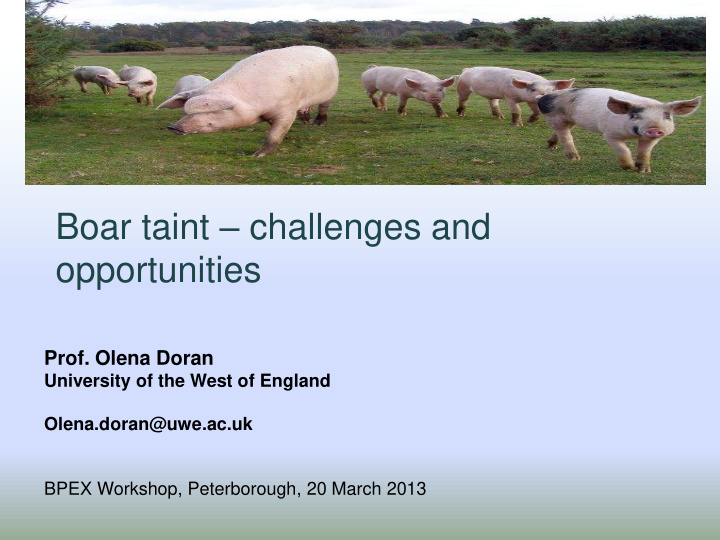



Boar taint – challenges and opportunities Prof. Olena Doran University of the West of England Olena.doran@uwe.ac.uk BPEX Workshop, Peterborough, 20 March 2013
Boar Taint An offensive odour in the meat of 5-10% of uncastrated male pigs Is mainly due to excessive accumulation of skatole and androstenone in pig adipose tissue
Adipose tissue Skatole Androstenone Liver Metabolism Excreted Salivary glands metabolites Testes Gut Androstenone Skatole
Situation in the UK • Surgical castration was phased out in the UK and Ireland during the 1980s • Low slaughter weight • Boar taint cannot be fully eliminated by early slaughter
EU position EU Directive on castration without anesthesia during the first week of life (2001/93/EC) Plan to voluntarily end surgical castration by 1 January 2018 (EU SANCO, 2010) European Partnership on Alternatives to Surgical Castration of Pigs Established (hedhttp://ec.europa.eu/food/animal/welfar)
Sources: Insitute for Food Reserach IRTA, PIGGAS project, Fredriksen, B., Font i Furnols, M., Lundström, K., Migdal, W., Prunier, A., Tuyttens, F.A.M. & Bonneau, M. 2009. Practice on castration of piglets in Europe. Animal, 1-8.
Estimated economic losses in Europe associated with raising entire male pigs • Current: 78.6 m Euro • 2018: 393 m Euro (EU Tender ALCASDE)
Potential solutions • Alternatives to surgical castration to prevent boar taint • Technologies for rapid detection of boar taint • Effective meat processing technologies
Surgical Castration Slaughtering at Lower weight Genetic selection Management/Diet Prevention of Boar Taint Immunocastration Semen Sorting
“ There are no harmonised methods of consistently identifying carcases with boar taint in commercial slaughter houses. Investigation of possible processing techniques to reduce the offensive properties of boar taint is hampered by the lack of such methods to asses levels of the compounds contributing to the phenomenon” (The EFSA Journal, European Food Safety Authority, 2004) Existing methods Technoloiges Under (examples) Development (examples) Chemical sensor-base and gas Spectophotometric sensor-based technologies (Mortensen and Sorensen, 1984) (i.e. Haugen, 2006; Vestergaard et al., 2006) Immunoassay Bio-sensors (Claus et al.,2008; Tuomola et al., 1997) Novel Technologies for Food Quality Gas and liquid chromatography developed at the University of the West of England (Annor-Frempong et al., 1997; have been listed among the top 100 areas Garcia-Regueiro and Diaz, 1989) which will have a profound effect on our future in the Research Council UK report “Big Ideas for the Future”, 2011
Examples of recent initiatives EU ALCASDE Project “Study on the improved methods for animal - friendly production, in particular on alternatives to the castration of pigs and on alternatives to the dehorning of cattle” EU: Health and Consumers Directorate General Tender “Study on rapid detection methods for boar taint used or being developed at slaughter plants in the European Union” “UK/China partnership for innovative technologies”.
UK-China partnership for innovative technologies Funder: UK Biotechnology and Biological Sciences Research Council (BBSRC) Leading organisation: University of the West of England Aims: To develop collaborative research and knowledge exchange in the area of novel technologies for food quality and safety To enhance links between industry and academia To develop UK/China staff exchange schemes http://rbi.uwe.ac.uk/chinapartnership/default.asp
Image from http://www.biosensores.com/EN/biosensores_afinidad_molecular.php
Advantages of biosensors Rapid Cost-effective Point-of-test analysis User-friendly Simultaneous multiple analysis Portable Can be adapted to other applications Display the results immediately
Examples of Bio-sensors developed at the Centre for Research in Biosciences (University of the West of England)
Gas sensors for detection of soft rot and Parma ham spoilage
Bio-sensors for detection organophosphate pesticides Commercially available portable device (Uniscan Instruments, UK)
Carbon Bio-sensor System for detection of ammonia Commercially available automated instrument (AET Ltd., UK)
Bio-luminescent bacteria based sensors Roger J. Lewis, Adam Baldwin, Tracey O'Neill, Habib A Alloush, Shona M Nelson, Tony Dowman, Vyv Salisbury, Journal of Food Engineering 2006 Vol 76 Pages: 41-48
Other applications • Glucose and lactate biosensors • Heavy metal sensors for liquids • Bio-sensors for progesterone and estradiol in milk • Magnetic immunoassay for food quality traits
??? • What is the scale of the market? • How much is industry prepared to pay? • What are the end-users requirements to the technology? • How to incorporate the new technology in industrial setting?
Conclusions EU legislations and initiatives emphasise the need in on- line detection of boar taint The need in boar taint detecting technology vary between countries and the sectors. A comprehensive market assessment is needed. A number of technologies for on-line boar taint detection are at various stages of development. Evaluation in industrial setting is essential. Harmonization of existing methods for boar taint detection is essential
Recommend
More recommend